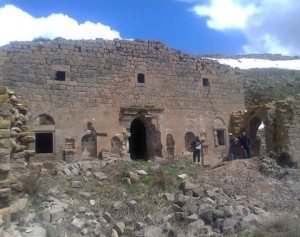MENDON, Mass.—From Hell to Heaven is not your ordinary book because it was actually written by a man who experienced the genocide first-hand and lived long enough to compile his own memoirs.

The work eventually wound up in the hands of a grandson who saw its way into publication, much like finding an oasis in the middle of an arid desert.
It tells the story of Armenag Bedigian-Antranigian, then a young man who, for almost two years, suffered the horrors of the Armenian Genocide in the Keghi region of Erzurum.
In the process, he witnessed the loss of all members of his family and miraculously survived by hiding in the mountains and gorges of Keghi while serving as a slave for Kurdish families.
“I owe a debt of gratitude to a number of individuals that finally resulted in this publication,” said Hagop Antranigian, Armenag’s grandson. “Although there are numerous documentations on the genocide, not so much has been recorded about the volunteer corps.”
In late 1916, Armenag Antranigian finally managed his escape to the Russian side of the war front and reached Erzurum. In 1917, he joined the Armenian volunteer forces for the defense of Erzurum. As a foot soldier, he served under General Antranig and participated in the military campaigns of Zankezur, Nakhichevan, and Khoy in northern Iran.
He spent a year in Tiflis, Georgia, as a refugee before reaching Constantinople in late 1919 and immigrating to the United States three years later.
“This book is a valuable eye-witness account by a mature and literate young man about life in the Armenian village of Keghi, the complicity of Kurds in the Armenian Genocide, the movement of the Armenian Volunteer Corps, and the plight of Armenian refugees from Erzurum to Tiflis,” said the grandson. “It’s a remarkable story that can be shared by all products of genocide.”
The memoir was compiled in the early 1940’s in handwritten Armenian. In 2000, it was translated into English by Vatche Ghazarian of Mayreni Publishing, but remained unpublished until now. The Armenian text also remains unpublished.
The 250-page work details Armenag Antranigian’s childhood and expatriation, his wedding, the Calamity, his escape from Dersim, role in the Armenian Volunteer Corps, and finally his migration from Constantinople to America, ultimately settling in Portland, Maine, where he gained employment as a shoe worker.
In his introduction, he tells readers: “Despite my determination to do so for years, I have not been able to write about the horrible days of deportation. However, they are fresh in my mind and heart. Although I have no intention on reopening my wounds, I may, perhaps, relieve my agony in retelling my story.”
Armenag Antranigian goes on to mention the loss of his home, land, and people—the death of his mother, brothers, sister-in-law, her children, and his very own wife, village, and nation.
“You will learn about the agony and pain of someone who, hungry and thirsty, wandered the mountains barefooted and naked, miserable and helpless,” he writes. “Even a beggar is free to wander the earth while we, as Armenians, were forced to hide like reptiles to avoid death.”
He goes on to add, quite poignantly, “A nation without a state is a nation without God. Had we a state of our own, the crimes and massacres may have been prevented.”
“I regret not my youth. I regret my lost happiness,” he concludes.
Others contributing to the book were Dr. Vazken Ghougassian (general editor), Iris Papazian (copy-editor), Mary Gulumian (technical support), Khajag Zeitlian (cover designer), and Osep Tokat, Prof. Robert Hewsen, and George Aghjayan (historians).
For Hagop Antranigian, the journey of locating his grandfather’s memoirs and getting them published was a 15-year mission of persistence.
“I’ve done a lot of reflection and feel very blessed to be a vital part of my Armenian Church and community,” he admits. “The avenues and branches that are continuously being uncovered through the information my grandfather left me are truly amazing.”


So, where can we obtain a copy of the book?
My great grandparents were also from Keghi can’t wait to read this
Would be happy to purchase copies of this book, please direct U.S.,
my grandfather Setrak Baghdoyan from Kghi and also wrote a book with a similar name in Armenian: “When Heaven Became Hell” published in 2006. I cant wait to read this one. Kkghetsis must have been well educated! Starting in the 20s, he wrote and rewrote it about 8 times final draft in the 60s. Marc Nishanian edited it and Abrile Books published it about 10 years ago. These eyewitness testimonies are the ultimate testament to an incredible generation of survivors who persevered despite their unthinkable eecperience. God bless them all
I too would buy the book if it’s available.
The book is available through the Armenian Prelacy bookstore at 138 East 39th Street, New York, NY.
Prelacy phone number for ordering book is (212) 689-7810
I admire the dedication of Mr. Antranigian in preserving his family’s story. I look forward to reading it.
My father-in-law was from Keghi. He was the only survivor from a family of nine. My father was also from the Keghi area but had been sent to Boston before 1915 to live his grandmother , who was also Dr. Varatzad Kazangian’s mother. Later, he lied about his age, so that he could join ARF volunteer forces, ending up in General Antranig’s army.